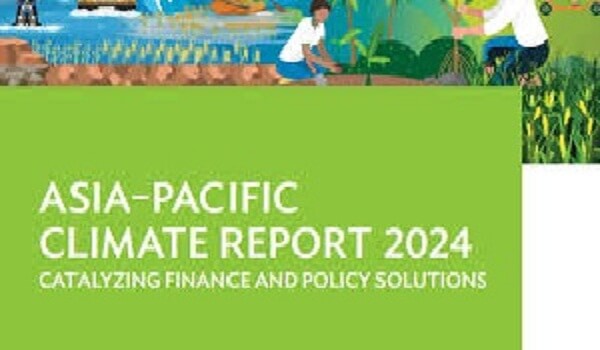The Asian Development Bank’s (ADB) *Asia-Pacific Climate Report 2024* highlights severe economic and environmental threats posed by climate change in the Asia-Pacific region, underscoring an urgent need for coordinated climate action. ADB estimates that under high-emission scenarios, the region’s GDP could drop by 17% by 2070, with losses potentially escalating to 41% by the century’s end if current trends continue. Major economic risks include rising sea levels, productivity declines, and increased damage from extreme weather events, affecting lower-income and coastal communities most severely.
To address these challenges, ADB stresses the importance of scaling up climate adaptation and mitigation investments. Current climate adaptation financing in the region, around $34 billion annually, is well below the estimated need of $102-431 billion per year. The report calls for substantial private-sector involvement and enhanced public investment to close this financing gap. ADB suggests policy reforms to encourage private sector participation, emphasizing carbon pricing mechanisms, regulatory incentives, and innovative financing models like blended finance.
Additionally, the report recommends expanding renewable energy adoption, strengthening infrastructure, and creating regional carbon markets to facilitate cost-effective emission reductions. By taking these steps, ADB envisions a pathway for Asia-Pacific nations to foster resilience, reduce emissions, and promote sustainable growth.
ADB’s report underscores the pressing need for both immediate adaptation measures and long-term, coordinated mitigation efforts to avert potentially devastating climate and economic impacts.
Highlights of report:
Evolving climate risks in Asia and the Pacific* Continuation of implemented policies will lead to dangerous levels of global warming. With the policies currently being implemented, around 3°C of warming is expected within this century. While pledges in nationally determined contributions (NDCs) could reduce this to 2.4°C, taking into account feedback effects implies that warming could happen faster than conventionally estimated.
Developing Asia both suffers from and contributes to the climate
crisis. The emissions intensity of the region’s economies has decreased by over 50% since 2000. However, the region still generated about half of global greenhouse gas emissions in 2021, driven by rising domestic consumption, energy demand, and production. Without stronger adaptation and mitigation efforts, the region faces severe impacts and substantial economic losses.
Many impacts in the Asia and Pacific region will be greater than indicated by global trends. Under a high end emissions scenario, relative sea-level rise and temperature increases in the region will exceed global averages. The destructive power of typhoons and cyclones will double, and flood losses will increase due to more concentrated rainfall and glacial melt. Climate-dependent sectors such as agriculture, forestry ,and fisheries will face diminished output. Hotter temperatures will reduce labor productivity,erode human and social capital, and increase mortality and health risks.
Climate change reduces gross domestic product in the region by 17% in 2070 under a high end emissions scenario. Sea-level rise and labor productivity effects dominate the losses, with relative effects concentrated in lower-income and fragile economies and those with large coastal populations. The impacts are regressive and hit vulnerable and poor people the hardest.
Public concern about climate change is high, as is support for ambitious climate action. The ADB climate change perception survey conducted in 2024 finds that 91% of respondents in 14 economies view climate change as a serious problem. Improving policy design, addressing inequalities, and increasing awareness about climate action can boost
public support.
Accelerating climate change adaptation
Adaptation is key to addressing large impacts. In the near term, only adaptation can alter climate losses. Effective adaptation policy must address both slow onset changes and a greater frequency and/or intensity of fast onset extreme events, while at the same time considering other development needs.
Early and coordinated investments are needed to avoid damage and enable transformational responses. Realizing adaptation opportunities requires enhanced analysis of climate change impacts and adaptation needs upstream in development planning. Although most countries have prepared National Adaptation Plans (NAPs) and included adaptation in their NDCs, they can still better integrate adaptation into medium-term development plans and expenditure frameworks.
Market reforms can enhance adaptive capacity by correcting market distortions. Adaptation is facilitated when climate signals are well transmitted and market actors have the freedom to respond. Strengthening property rights can encourage better incorporation of climate risks. Removing subsidies for water and other natural resources can curb the
overuse that exacerbates scarcity and damage. More open trade can diversify supply chains, stabilize markets, and promote the spread of adaptation technologies.
Both public and private sources are key to closing the adaptation financing gap. Annual financing needs for adaptation in the region are estimated to be between $102 billion and $431 billion. Nearly half of modeled needs are for coastal and river flood protection. The needs far exceed the approximately $34 billion of tracked adaptation finance that was committed in the region in 2021–2022.
Continuous reassessment of climate change impacts and adaptation actions is essential. Policymakers must continually revisit and improve predictions of impacts and systematically test adaptation measures to ensure that adaptation policy addresses evolving challenges. The results of this ongoing reassessment must be communicated continuously to ensure that climate risks are internalized in planning and investment processes. Scaling up private climate capital
Private capital is increasingly becoming a source of climate finance, but more needs to be done. Climate-related risks and regulatory changes are pushing more private capital into climate-aligned investments. However, policy uncertainties and misalignments, unreliable information disclosure, and weak enabling financial markets are constraints to raising private climate capital.
Greater policy certainty and financial sector reform can attract private climate capital. Governments can adopt a comprehensive set of aligned policies featuring a mix of price and nonprice policies, such as carbon pricing and clean energy subsidies, to enhance the profitability of climate investments and provide consistent incentives. Policymakers can develop climate-oriented financial systems through the adoption of sustainability disclosure standards to reduce transaction costs and compliance risks for investors.
The public sector can help overcome barriers to private climate investment. Solutions like blended finance can facilitate the use of de- risking instruments, such as first-loss guarantees, insurance, and credit enhancements, to attract private investors. Blended finance can also generate demonstration effects for new technologies. The public sector can
strengthen the investment environment by liberalizing markets, reducing entry barriers, and overcoming market rigidities such as long-term power purchase agreements. Multilateral development banks can support these efforts with their capital and their menu of instruments.
Carbon pricing for more cost-effective mitigation
Carbon pricing instruments are gaining momentum in the region. Eight national initiatives are currently being implemented, while three countries are considering a domestic emissions trading system (ETS). However, these efforts are challenged by the continued significant financial support for fossil fuel subsidies.
Carbon taxation can be a powerful mechanism to reduce emissions cost-effectively. A carbon tax is not only an efficient approach to reducing emissions, but can also raise significant revenues that could be redirected to the highest-value public uses. Existing studies suggest that the adverse impact of a carbon tax on growth, inflation, and overall employment is likely to be small. Furthermore, policymakers have options to make the
distributional effects more progressive, including through targeted transfers, anti- poverty programs, or reducing regressive taxes.
There are several important lessons on ETS for the region. Efficiency- based targets balance emission reduction and production expansion goals but may not reduce emissions sufficiently. Institutional and regulatory frameworks as well as monitoring, reporting, and verification systems are critical and require significant effort and careful legislation.
The ETS can work more effectively with more carbon prices passed through the power market. Allowing offsets in an ETS can increase flexibility to help meet targets.
Developing economies can leverage international carbon markets to meet climate goals. Purchasing credits can help meet NDCs, especially when domestic abatement costs are high. However, developing national carbon market strategies is essential for effective engagement with international markets, effective NDC accounting frameworks, and voluntary market participation.





